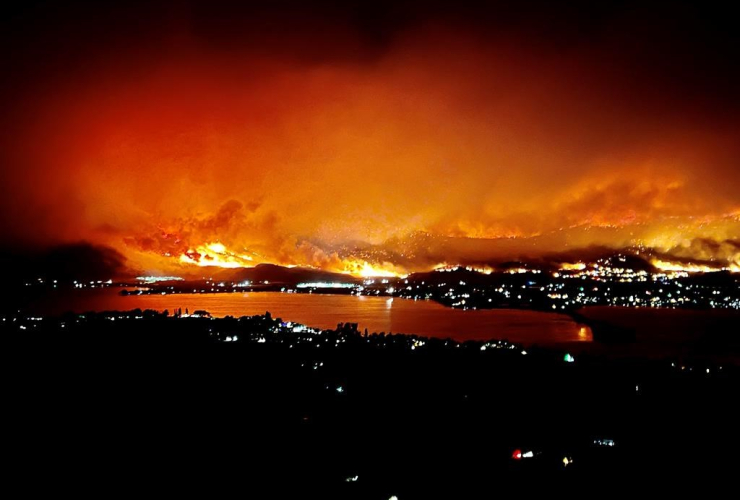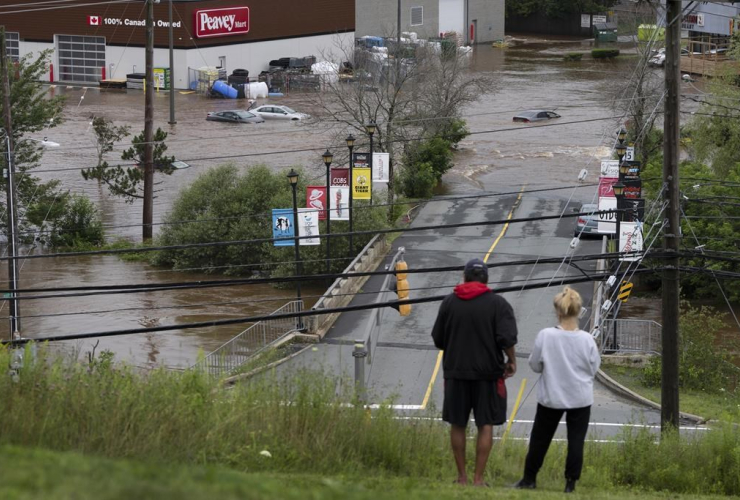At about summer's halfway point, the record-breaking heat and weather extremes are both unprecedented and unsurprising, hellish yet boring in some ways, scientists say.
Killer heat. Deadly floods. Smoke from wildfires that chokes.
And there’s no relief in sight.
Expect a hotter than normal August and September, American and European forecast centers predict.
“We are seeing unprecedented changes all over the world,” said NASA climate scientist Gavin Schmidt. “The heat waves that we’re seeing in the U.S. and in Europe, in China are demolishing records left, right and center. This is not a surprise.”
Imperial College of London climate scientist Friederike Otto said examining what's causing heat waves is “boring” in a way since it keeps happening. Yet she added that it matters “because it shows again just how much climate change plays a role in what we are currently experiencing.”
“This story, these impacts, are going to continue,” Schmidt said. “We’re going to be seeing this pretty much this year and into next year" with a natural El Niño warming of the Pacific adding to the overwhelming influence of human-caused climate change largely from the burning of coal, oil and gas.
Here’s a rundown of the summer of Earth's discontent.
Record-shattering heat
Globally, June this year was the hottest June on record — and scientists say July has been so hot that even before the month was over they could say it was the hottest month on record. But it’s individual places where people live that the heat has stuck around and killed.
Phoenix, where the last day of June and each day of July has been at least 110 degrees (43 degrees Celsius), set records for the longest mega-heat streak and longest stretch when the temperatures didn’t go below 90 degrees (32 degrees Celsius) at night.
El Paso, Texas, had 44 days of 100 degree (37 degree) heat. Schools closed in Nuevo Leon state in northern Mexico a month earlier than usual as temperatures reached 113 degrees (45 Celsius).
Farther east, Miami added humidity to high heat for 46 straight days of feels-like temperatures of 100 or more.
Beijing had its own record streak with at least 27 days of 95 degrees (35 Celsius) in July, after a three-day streak of at least 104 (40 Celsius) in June. And the country set it’s all-time highest temperature on July 16 in remote Sanbao township with 126 degrees (52.2 Celsius).
Heat records fell all over southern Europe. Sardinia, Italy, hit 117 (47 Celsius). Palermo in Sicily broke a record that goes back to 1791 by a whopping 3.6 degrees (2 degrees Celsius). Temperatures hit 115 (46 Celsius) in Gytheio, Greece.
Spain reported nearly 1,000 excess deaths from the heat, mostly among the elderly, by mid July.
In Argentina, where it's mid-winter, temperatures were above 89.6 (32 Celsius) four straight days in June in the northern part of the county. One July night in Buenos Aires didn’t get below the 70s (low 20s Celsius).
Too much rain
More than 10,000 people had to be evacuated in central Hunan province in China where heavy rainfall caused at least 70 houses to collapse. In Yichang, rain triggered a landslide that buried a construction site and killed at least one person.
Australia’s Queensland outback got 13 times its normal monthly July rain in just one day.
Thousands of people were evacuated from Delhi in India as rains caused flash floods and landslides. Elsewhere in the country at least 100 people were killed by the downpours.
In the United States, sudden heavy rain killed people in Vermont, Connecticut and Pennsylvania with tragic stories of children washed away in flooding.
Wildfires and smoke
Too little rain in Greece and Spain fed wildfires that proved difficult to fight. In the Canary Islands, a fire caused 4,000 people to evacuate, others to wear face masks and had 400 firefighters battling it.
Hot and dry conditions caused about 160 wildfires to break out in Israel in early June.
But what really brought fires home happened in parts of Canada where few people live. Rare far northern Quebec wildfires triggered nasty smoke that inflicted the world’s dirtiest air on cities like New York and Washington, then switched to the Midwest.
As of late July more than 600 wildfires were out of control in Canada. A record 47,490 square miles (123,000 square kilometers) burned, and fire season isn’t near done. That’s an area larger than the state of Pennsylvania or North Korea.
Water temperatures
Water temperatures in the Florida Keys and off the Everglades hit the high 90s (high 30s Celsius) with Manatee Bay breaking 100 degrees twice in what could be an unofficial world record for surface water temperature, although that’s in dispute.
The North Atlantic had hot spots that alarmed scientists. The world’s oceans as a whole were their hottest ever in June and got even hotter in July. In Antarctica, sea ice smashed record-low levels.
Ocean temperatures take a long time to warm up and cool down, said University of Northern Illinois meteorology professor Victor Gensini. So it doesn’t look good for the rest of the summer, he said.
A hot forecast
“We are favoring above normal temperatures for the next three months,” said NOAA Climate Prediction Center meteorologist Matt Rosencrans.
The only potential relief he sees, especially in the hot Atlantic and Gulf of Mexico, is if a hurricane or tropical storm moves through.
The peak of hurricane season in September hasn’t even started.
When going through the litany of this summer's weather extremes so far, University of Pennsylvania climate scientist Michael Mann had one question: “How on God’s Earth are we still burning fossil fuels after witnessing all this?”
___
Researcher Rhonda Shafner contributed to this report from New York.
Follow AP’s climate and environment coverage at https://apnews.com/hub/climate-and-environment
___
Follow Seth Borenstein on Twitter at @borenbears
___
Associated Press climate and environmental coverage receives support from several private foundations. See more about AP’s climate initiative here. The AP is solely responsible for all content.
Seven years ago I went to see
Seven years ago I went to see my Member of Parliament, a newly elected Liberal, on the matter. There was no evident effect. How do we get their attention? Extinction Rebellion seems to have the best answer.





Comments